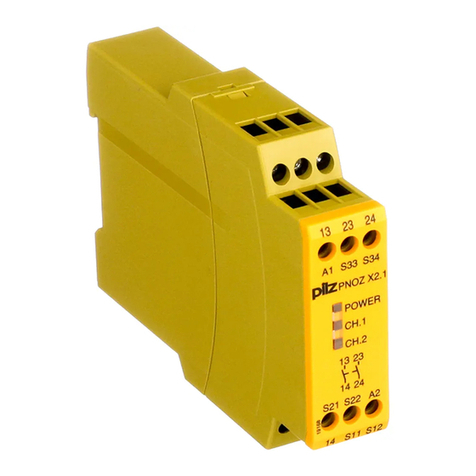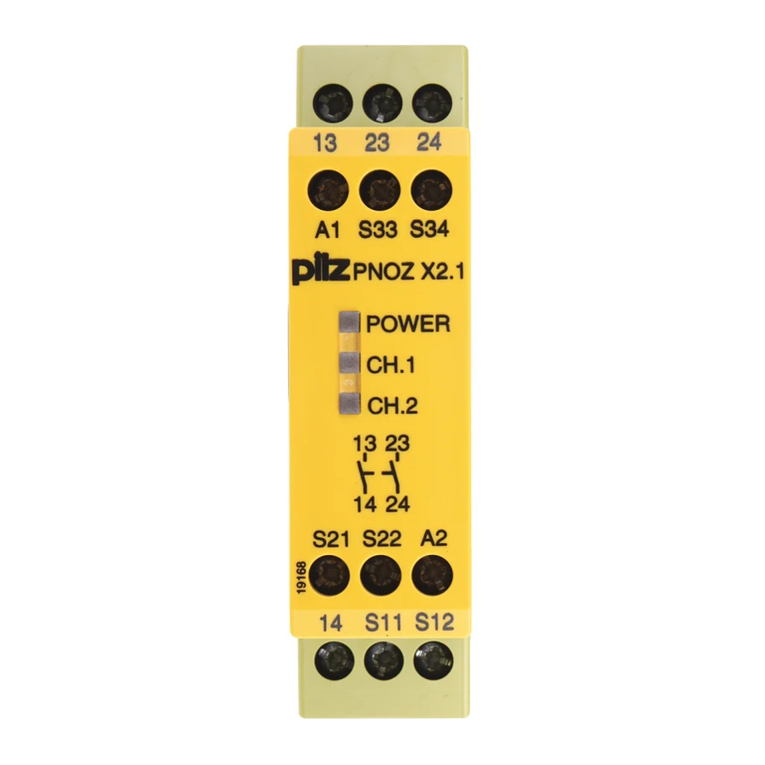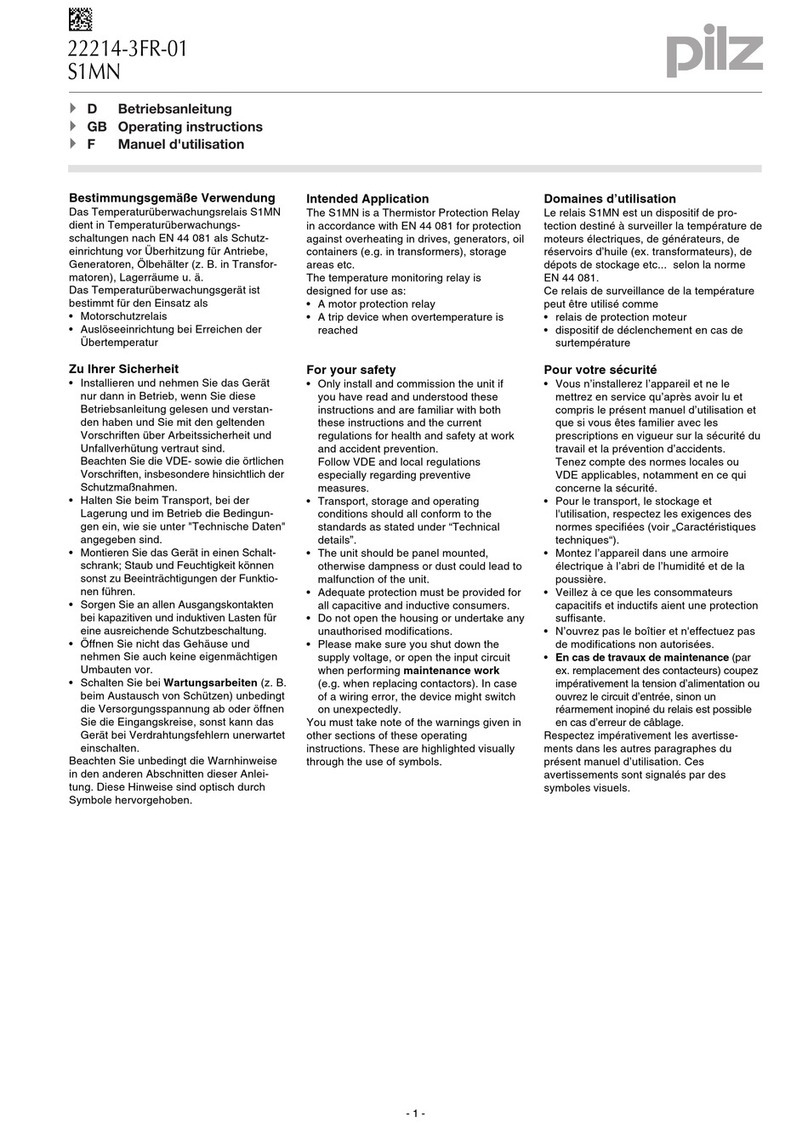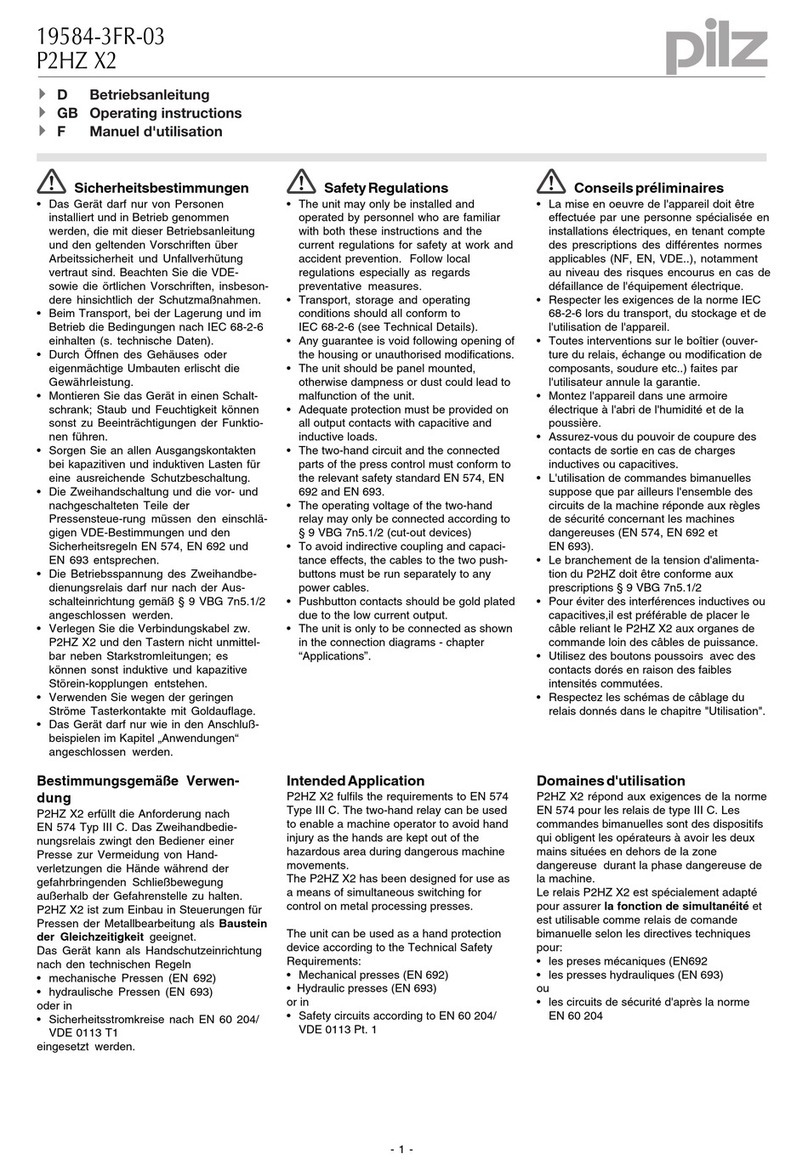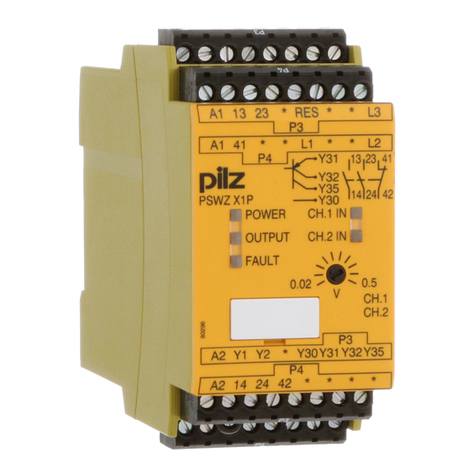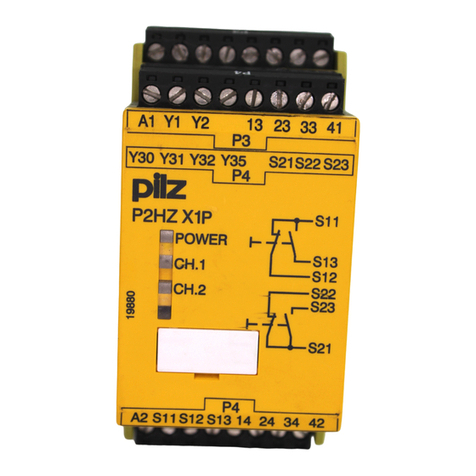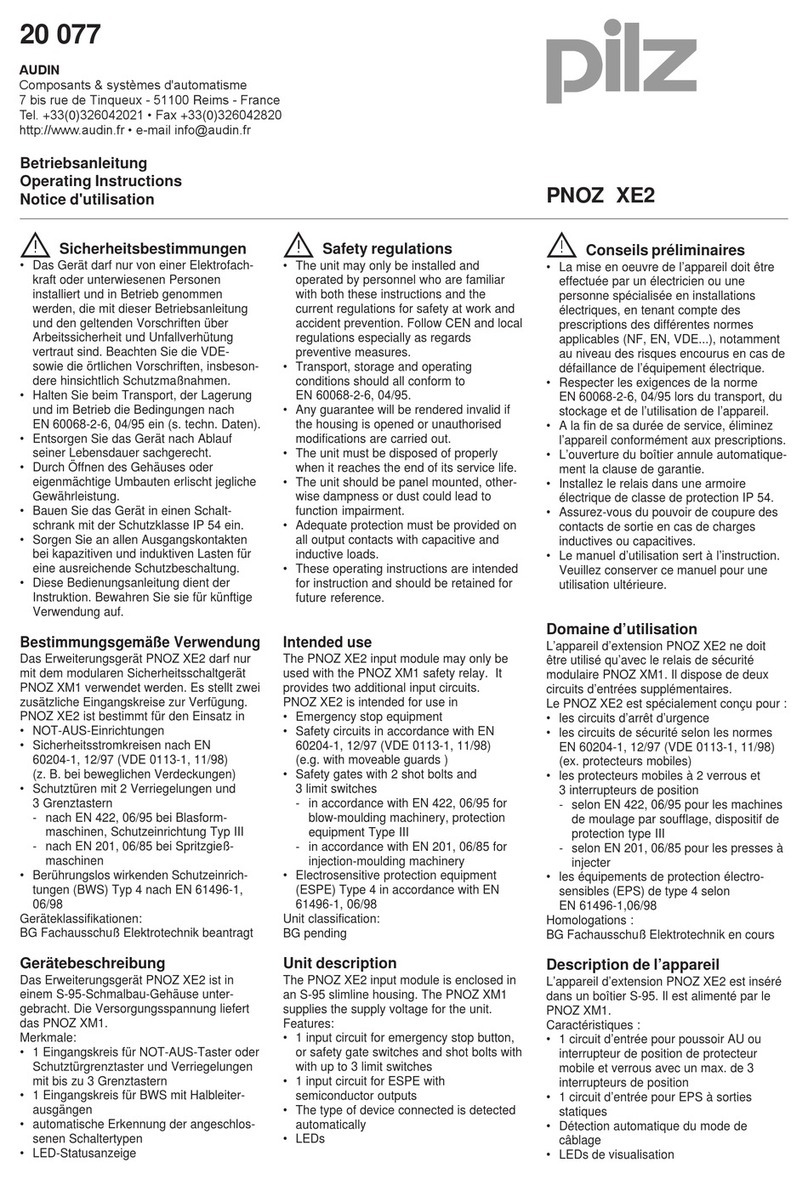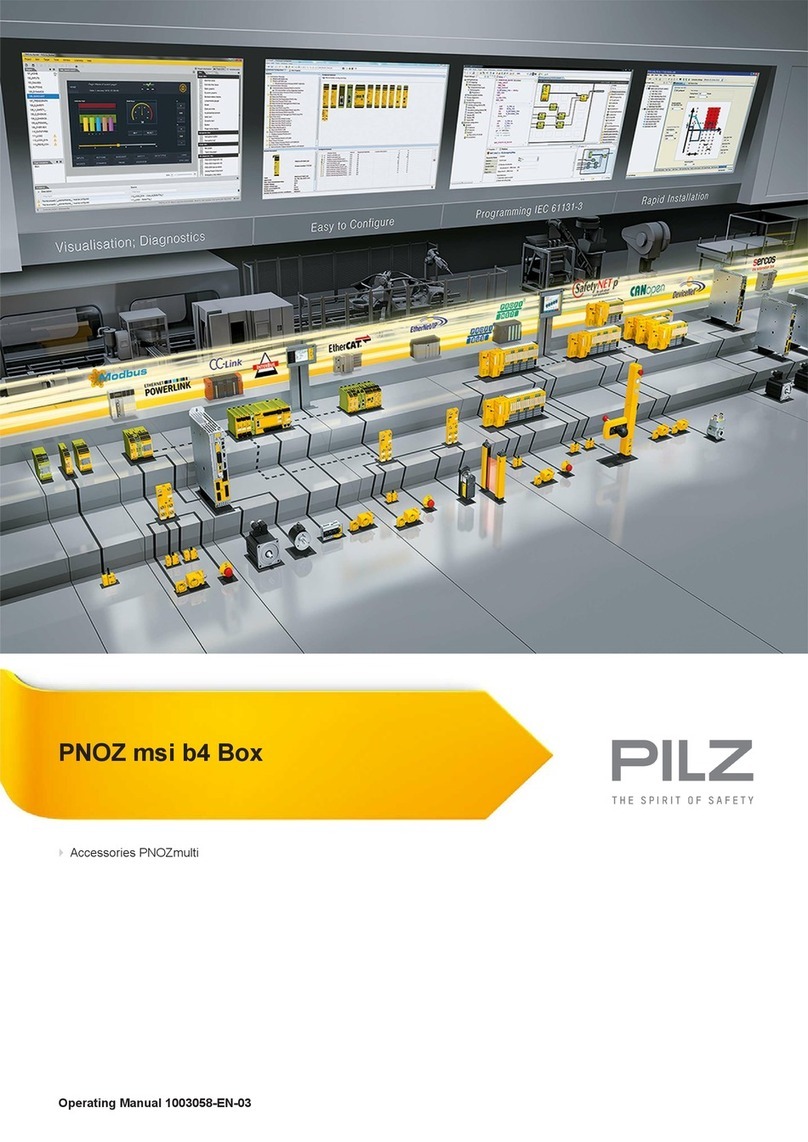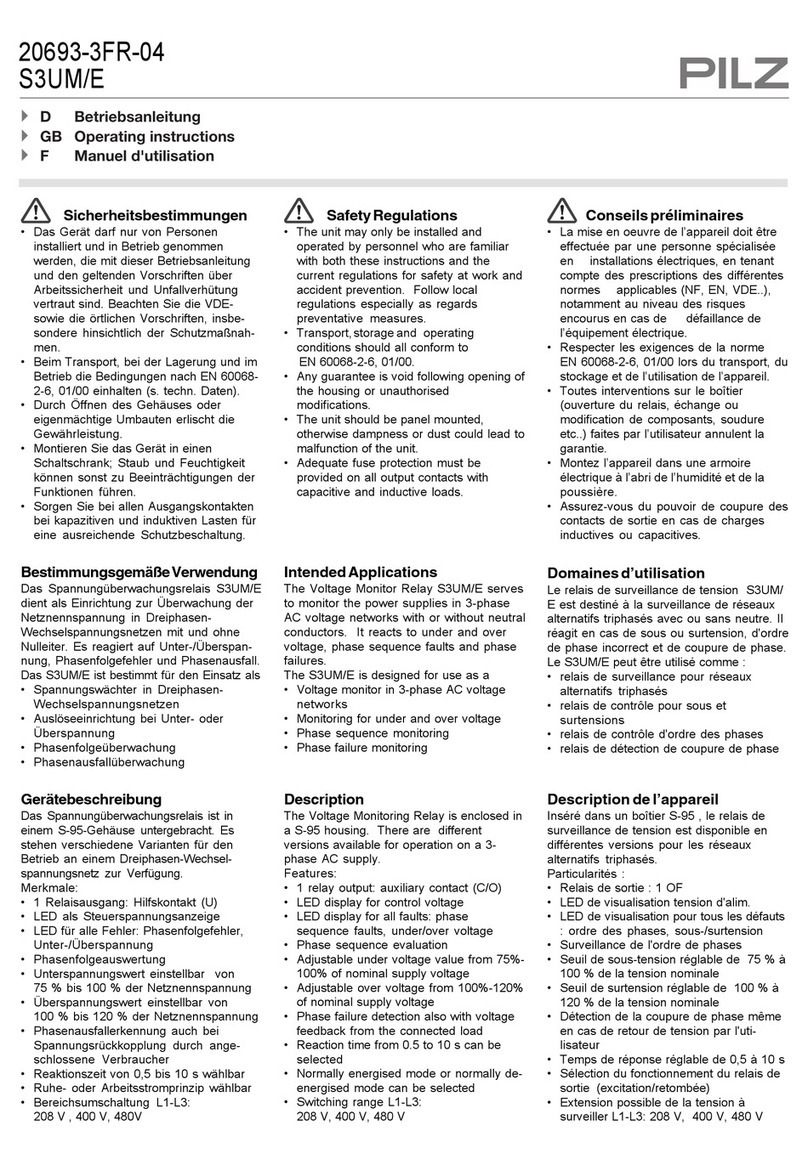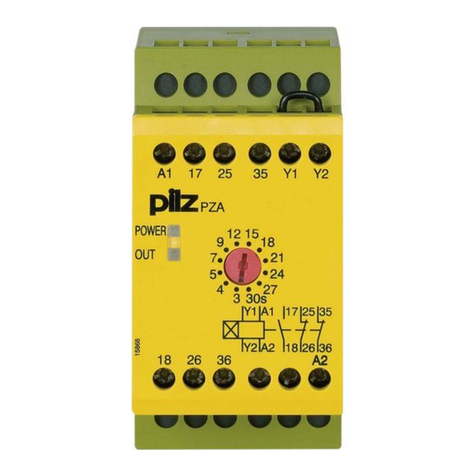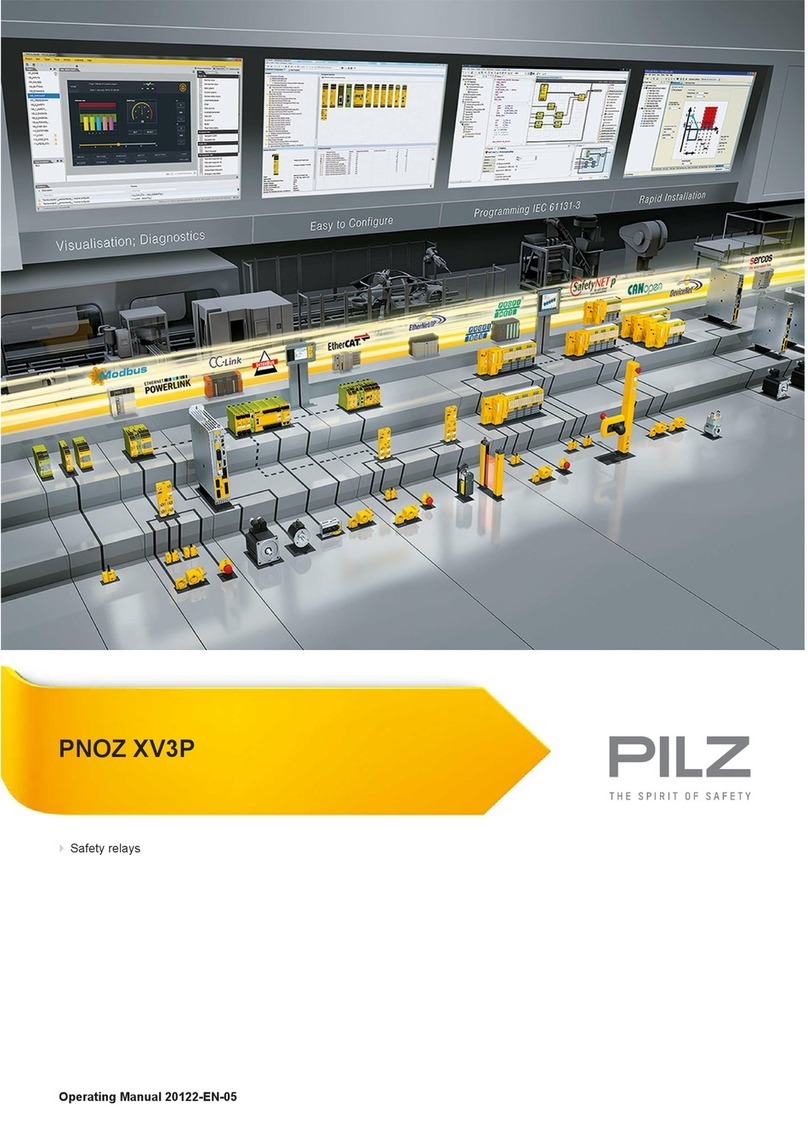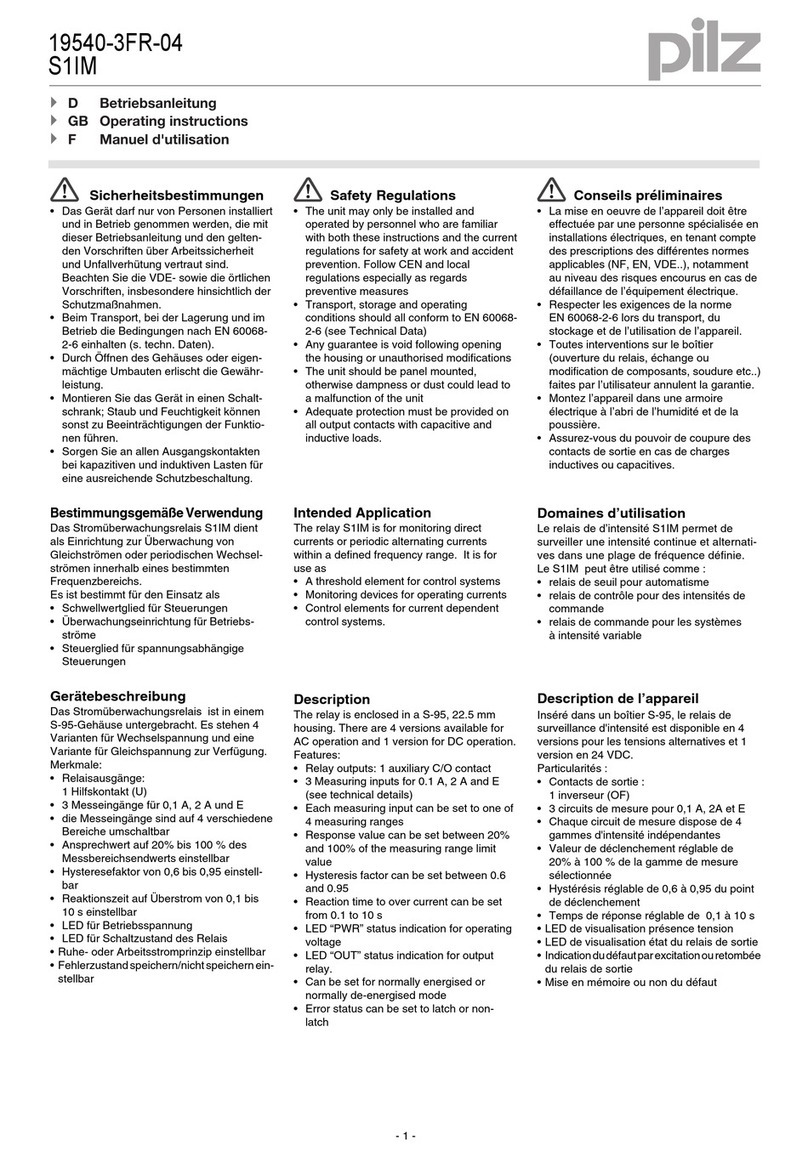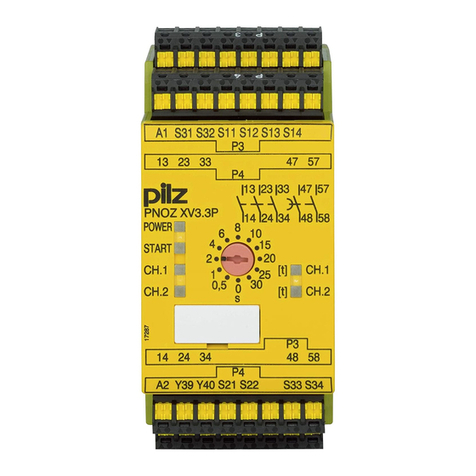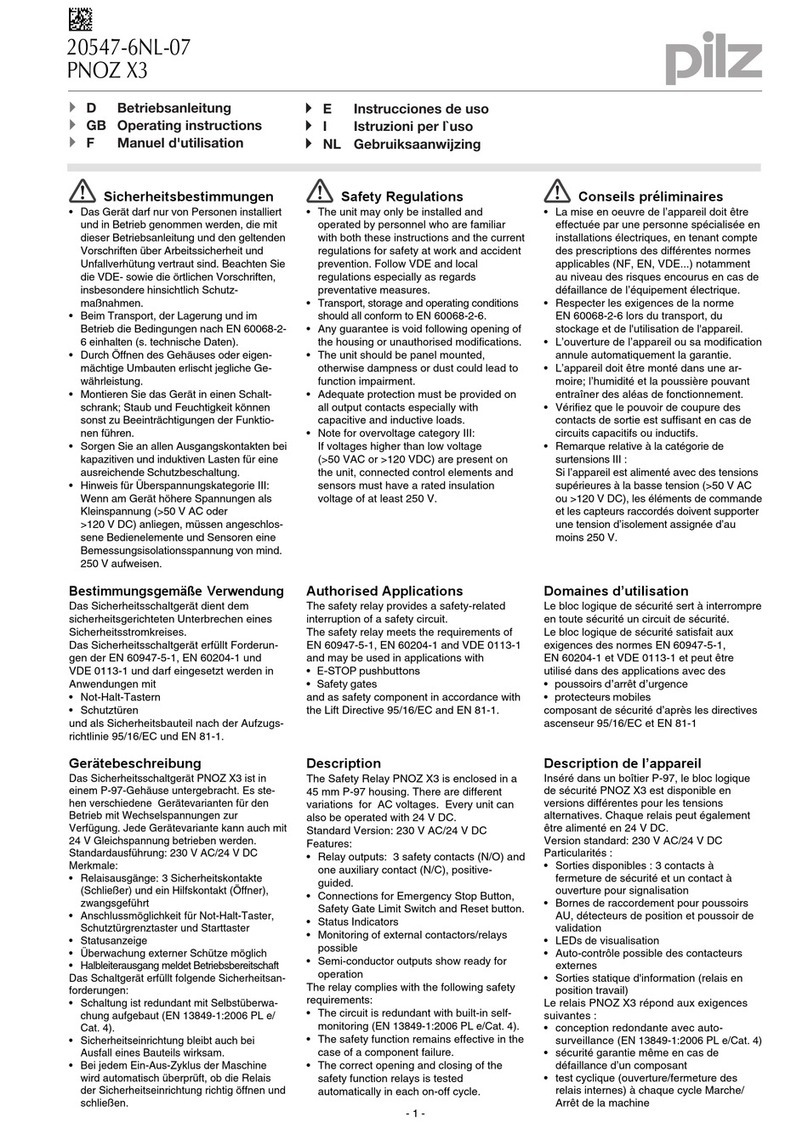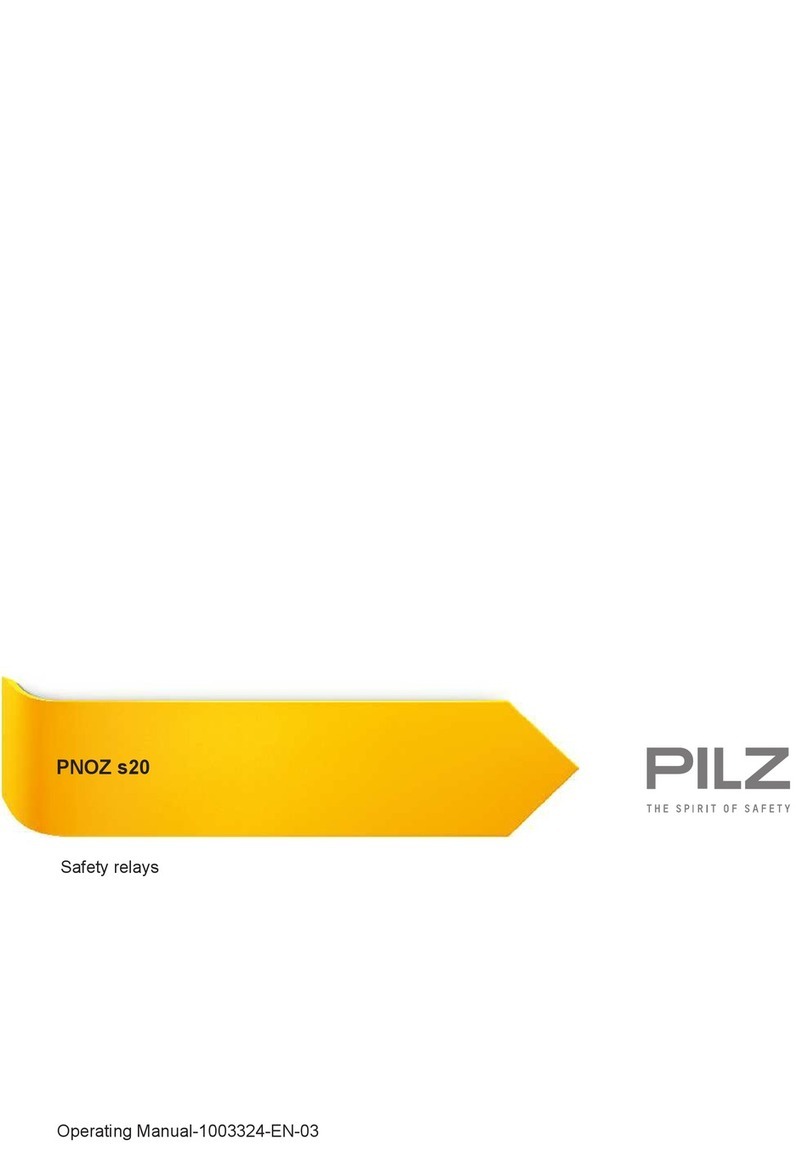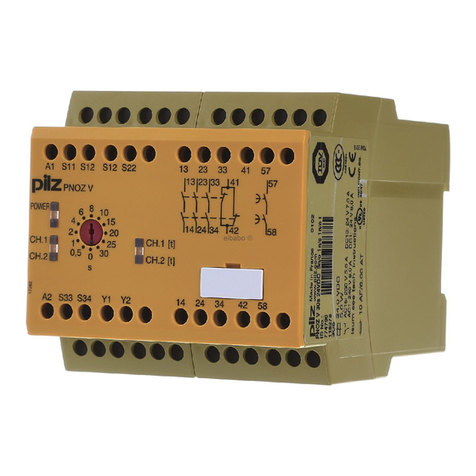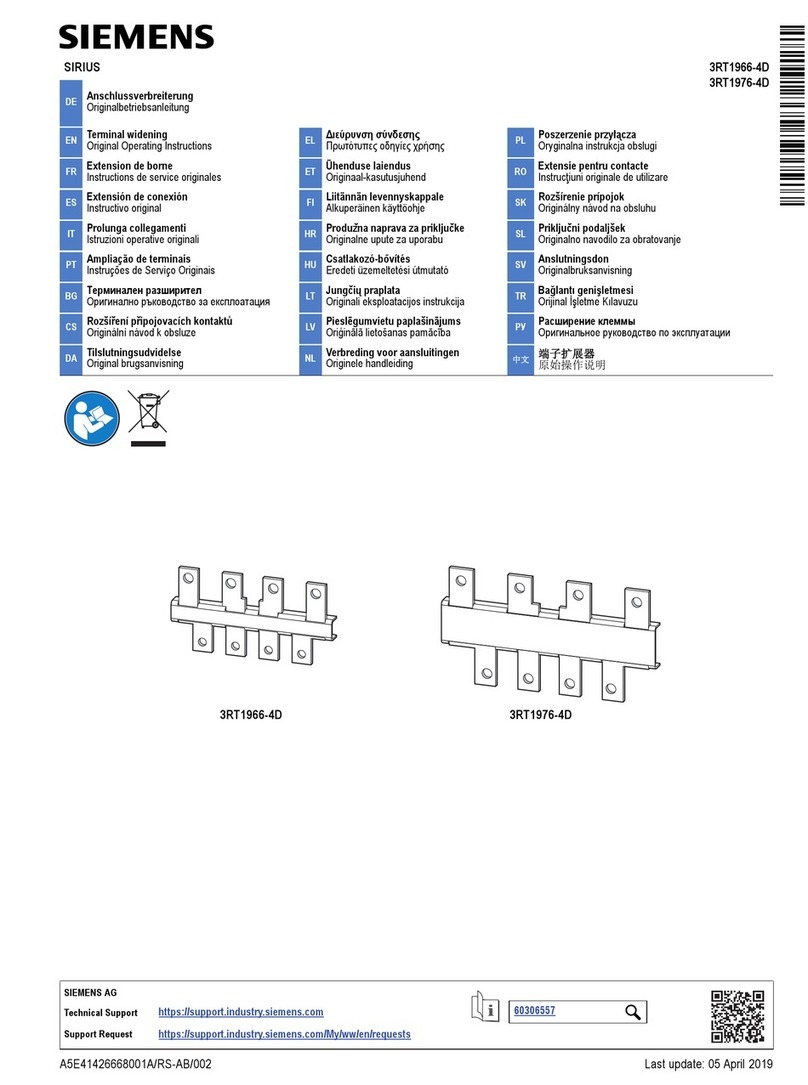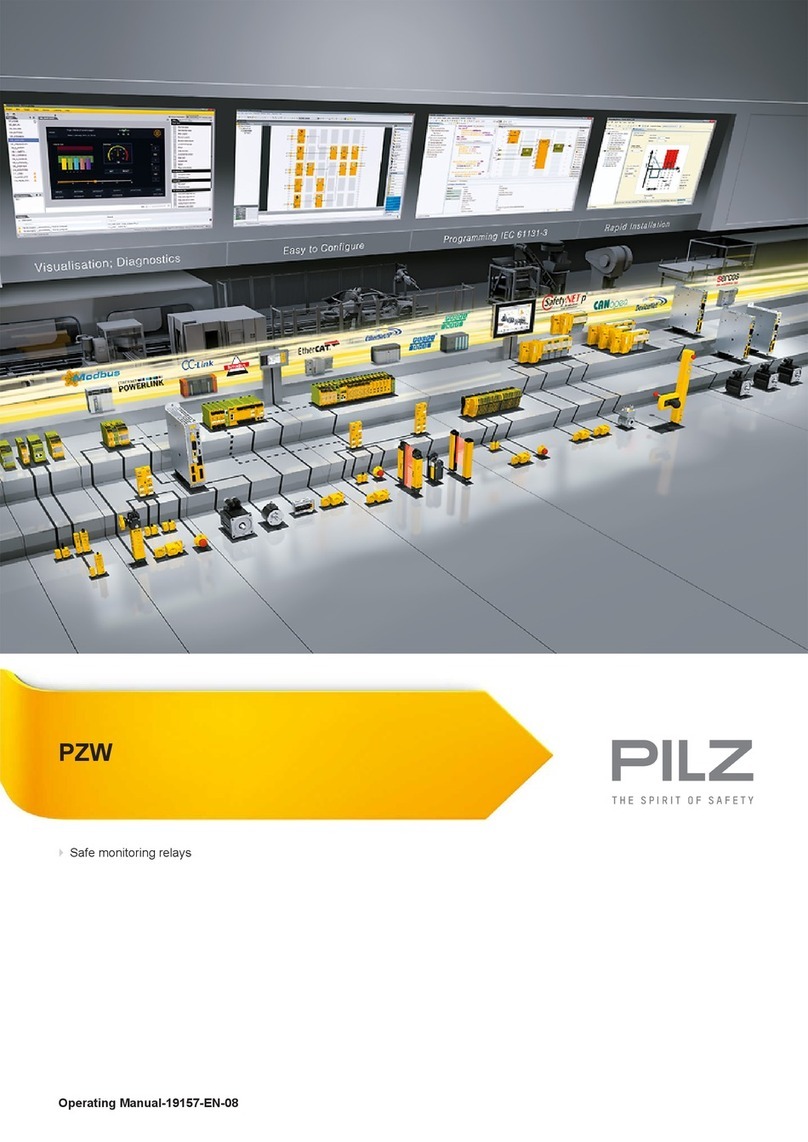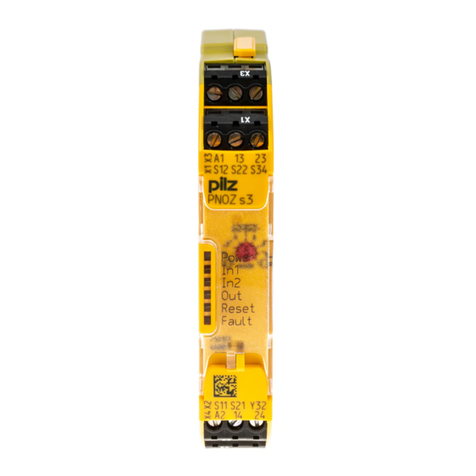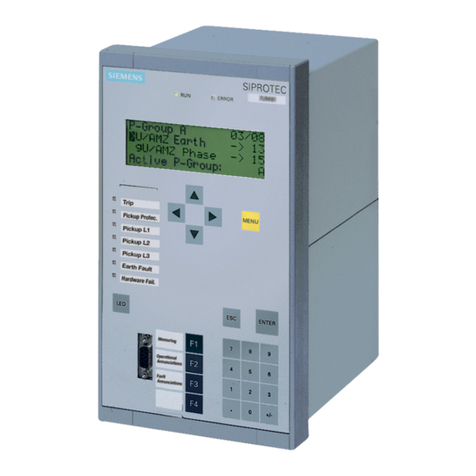
- 9 -
Normas de seguridad
•
El dispositivo tiene que ser instalado y
puesto en funcionamiento exclusivamente
por personas que estén familiarizadas
tanto con estas instrucciones de uso como
con las prescripciones vigentes relativas a
la seguridad en el trabajo y a la prevención
de accidentes. Hay que observar tanto las
prescripciones VDE como las prescripci-
ones locales, especialmente en lo que se
refiere a las medidas de protección.
• Durante el transporte, el almacenaje y el
funcionamiento hay que atenerse a las
condiciones conforme a EN 60068-2-6
(véanse los datos técnicos).
• La garantía se pierde en caso de que se
abra la carcasa o se lleven a cabo
modificaciones por cuenta propia.
• Montar el dispositivo dentro de un armario
de distribución; en caso contrario es
posible que el polvo y la suciedad puedan
afectar el funcionamiento.
• Hay que cuidar de que haya un
conexionado de seguridad suficiente en
todos los contactos de salida con cargas
capacitivas e inductivas.
• La función de seguridad debe ejecutarse
por lo menos una vez al mes.
Campo de aplicación adecuado
El dispositivo de seguridad PNOZ X2P está
concebido para ser empleado en
•
dispositivos de PARADA DE EMERGENCIA
• circuitos de seguridad según VDE 0113-1
y EN 60204-1 (p. ej. con cubiertas
móviles)
Descripción del dispositivo
El dispositivo de seguridad PNOZ X2P está
montado dentro de una carcasa S-99. Se
puede poner en servicio con 24 V de
tensión continua o alterna, o bien con
48 ... 240 V de tensión continua o alterna.
Características:
• Salidas de relé: 2 contactos de seguridad
(normalmente abiertos), de guía forzosa
• Posibilidad de conexión para pulsador de
PARADA DE EMERGENCIA, interruptor
límite de puerta protectora y pulsador de
rearme
• Indicación de estado
• Supervisión posible de contactores
externos
• 24 V CA/CC: sin separación galvánica
• 48 ... 240 V CA/CC: con separación
galvánica
El dispositivo cumple los requisitos de
seguridad siguientes:
• El cableado está estructurado de modo
redundante con autosupervisión.
• El equipo de seguridad permanece activo
aún cuando falle uno de los componentes.
• En cada ciclo de conexión/desconexión de
la máquina, se verifica automáticamente,
si los relés de la instalación de seguridad
se abren y se cierran correctamente.
19 798-01
PNOZ X2P
4E Instrucciones de uso
4I Istruzioni per l`uso
4NL Gebruiksaanwijzing
Norme di sicurezza
• Il dispositivo può venire installato e
messo in funzione solo da persone che
conoscono bene le presenti istruzioni per
l’uso e le disposizioni vigenti riguardo alla
sicurezza di lavoro e all’antinfortunistica.
Osservare le disposizioni della VDE
nonché le norme locali, soprattutto per
quanto riguarda le misure preventive di
protezione.
• Per il trasporto, l’immagazzinamento e
durante l’esercizio attenersi alle norme
EN 60068-2-6 (v. Dati tecnici).
• Se viene aperta la custodia oppure se
vengono apportate delle modifiche in
proprio decade qualsiasi diritto di
garanzia.
• Montare il dispositivo in un armadio
elettrico; altrimenti la polvere e l’umidità
possono pregiudicare le funzioni.
• Preoccuparsi che tutti i contatti di uscita
sui carichi capacitivi e induttivi siano
dotati di un circuito sicurezza sufficiente.
• La funzione di sicurezza deve essere
attivata almeno una volta al mese.
Uso previsto
Il modulo di sicurezza PNOZ X2P è
concepito per essere utilizzato in
• dispositivi di arresto di emergenza
• circuiti elettrici di sicurezza secondo la
norma VDE 0113-1 e EN 60204-1
(ad es. in caso di protezioni mobili)
Descrizione
Il modulo di sicurezza PNOZ X2P è
sistemato in una custodia S-99. Esso
può funzionare con tensione alternata o
tensione continua 24 V o con tensione
alternata o tensione continua 48 ... 240 V.
Caratteristiche:
•
Uscite relè: 2 contatti di uscita (contatto NA)
,
con contatti guidati
• Possibilità di collegamento per pulsante di
arresto di emergenza, finecorsa riparo
mobile e pulsante di start
• Visualizzazione di stato
• Possibile controllo di relè esterni
• 24 V AC/DC: nessuna separazione
galvanica
• 48 ... 240 V AC/DC: separato
galvanicamente
Il dispositivo elettrico risponde ai seguenti
requisiti di sicurezza:
• Il circuito è strutturato in modo ridondante
con autocontrollo.
• Il dispositivo di sicurezza funziona anche
in caso di guasto di un componente.
• Per ciascun ciclo di inserimento-
disinserimento della macchina,
viene eseguita la verifica automatica della
corretta apertura e chiusura dei relè del
dispositivo di sicurezza.
Veiligheidsvoorschriften
• Het apparaat mag uitsluitend worden
geïnstalleerd en in bedrijf genomen door
personen die vertrouwd zijn met deze
gebruiksaanwijzing en met de geldende
voorschriften op het gebied van arbeids-
veiligheid en ongevallenpreventie. Neem
de van toepassing zijnde Europese
richtlijnen en de plaatselijke voorschriften
in acht, in het bijzonder m.b.t. veiligheids-
maatregelen.
• Neem bij transport, opslag en in bedrijf de
richtlijnen volgens EN 60068-2-6 in acht
(zie technische gegevens).
• Het openen van de behuizing of het
eigenmachtig veranderen van de
schakeling heeft verlies van de garantie
tot gevolg.
• Monteert u het apparaat in een schakel-
kast. Stof en vochtigheid kunnen anders
de werking nadelig beïnvloeden.
• Zorgt u bij capacitieve of inductieve
belasting van de uitgangscontacten voor
adequate contactbeschermings-
maatregelen.
• De veiligheidsfunctie moet ten minste een
keer per maand geactiveerd worden.
Gebruik volgens de voorschriften
Het veiligheidsrelais PNOZ X2P is bestemd
voor gebruik in
• noodstopvoorzieningen
• veiligheidscircuits volgens VDE 0113-1 en
EN 60204-1 (b.v. bij beweegbare
afschermingen)
Apparaatbeschrijving
Het veiligheidsrelais PNOZ X2P is in een
S-99-behuizing ondergebracht. Het relais
kan met 24 V wissel- of gelijkspanning of
met 48 ... 240 V wissel- of gelijkspanning
gebruikt worden.
Kenmerken:
•
Relaisuitgangen: 2 veiligheidscontacten
(maakcontacten), mechanisch gedwongen
• Aansluitmogelijkheid voor noodstop-
knoppen, hekschakelaars en de startknop
• Statusweergave
• Bewaking van externe magneet-
schakelaars mogelijk
• 24 V AC/DC: geen galvanische scheiding
•
48 ... 240 V AC/DC: galvanisch gescheiden
Het relais voldoet aan de volgende
veiligheidseisen:
• De schakeling is redundant met zelf-
bewaking opgebouwd.
• Ook bij uitvallen van een component blijft
de veiligheidsschakeling werken.
• Bij elke aan/uit-cyclus van de machine
wordt automatisch getest of de relais-
contacten van de veiligheidsvoorziening
correct openen en sluiten.
